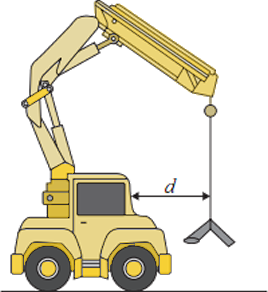GCSE Questions: Moments and Centre of Gravity
Q2.The diagram shows a small mobile crane that is used on a building site.
The distance, d, is measured to the front of the cab.

The table below shows information from the crane driver's handbook.
| Load/kN |
Maximum safe distance 'd' /m |
| 10 |
6.0 |
| 15 |
4.0 |
| 24 |
2.5 |
| 40 |
1.5 |
| 60 |
1.0 |
(a) What is the relationship between the load and the maximum safe distance?
Any two from:
- inversely proportional as the load gets bigger

- the (maximum safe) distance gets less

- load × distance = 60 (kN m)

(2 marks)
(b) The crane driver studies the handbook and comes to the conclusion that a load of 30 kN would be safe at a distance, d, of 2.0 metres.
Is the driver correct?
Explain your answer.
Yes,  because the moment produced by the load is 30 × 2 = 60
because the moment produced by the load is 30 × 2 = 60  kNm and that won't make the crane topple over.
kNm and that won't make the crane topple over.
(2 marks)
(c) What is the danger if the driver does not follow the safety instructions?
The crane will topple over. 
(1 mark)
(d) How should the data in the table have been obtained?
A: average results from an opinion poll of mobile crane drivers
B: copied from a handbook for a similar crane
C: results of experiments on a model mobile crane
D: results of experiments on this mobile crane 
(1 mark)
(Total 6 marks)







